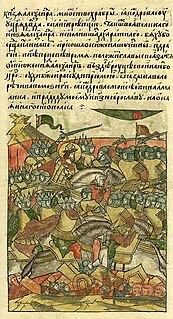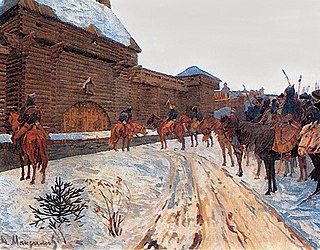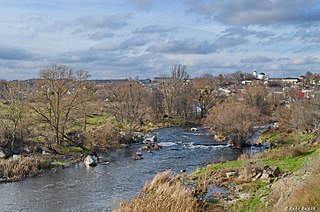 W
WThe Battle of the Sit River was fought in the northern part of the present-day Sonkovsky District of Tver Oblast of Russia, close to the selo of Bozhonka, on March 4, 1238 between the Mongol Hordes of Batu Khan and the Rus' under Grand Prince Yuri II of Vladimir-Suzdal during the Mongol invasion of Rus.
 W
WSack of Chernigov was part of the Mongol invasion of Rus.'
 W
WThe Galician–Volhynian Chronicle is a prominent benchmark of the Old Ruthenian literature and historiography covering 1201–1292 in the history of the Principality of Galicia-Volhynia. The original chronicle did not survive; the oldest known copy is in the Hypatian Codex. It was discovered in 1809 by the Russian historian and opinion writer Nikolay Karamzin as a final part of the 15th century Hypatian Codex. He also found the second codex of the Galician–Volhynian Chronicle, the 16th century Khlebnikovsky Codex. All other known today to science six codices of the Galician–Volhynian Chronicle including the Hypatian Codex start from the Khlebnikovsky Codex.
 W
WGleb Yurievich (Russian: Глеб Юрьевич,, Prince of Kursk, Kanev, Pereyaslavl and Grand Prince of Kiev. He was a son of Yuri Dolgorukiy.
 W
WLife of Alexander Nevsky is a Russian illuminated manuscript of the late 16th century (1560-1570). It is currently housed in the Saltykov-Shchedrin Public Library in Saint Petersburg, Russia.
 W
WThe Siege of Moscow was part of Mongol invasion of Rus.
 W
WSviatoslav Olgovich was the Prince of Novgorod (1136–1138); Novgorod-Seversky (1139); Belgorod Kievsky (1141–1154); and Chernigov (1154–1164). He was the son of Oleg Sviatoslavich, Prince of Chernigov with an unnamed daughter of Asaduk, Khan of Khumans.
 W
WThe Ros is a river in Ukraine, a right tributary of the Dnieper. The Ros finds its source in the village of Ordyntsi in Pohrebyshche Raion, Vinnytsia Oblast. It is 346 kilometres (215 mi) long, and has a drainage basin of 12,600 square kilometres (4,900 sq mi). Larger settlements on the river are Bila Tserkva, Bohuslav, and Korsun-Shevchenkivskyi.
 W
WRuś Szlachtowska was a name introduced in 1930s by Prof. Roman Reinfuss to denote the region surrounding four villages in the Grajcarek valley in the Pieniny mountains, in the Nowy Targ County of southern Poland.
 W
WRyasna was a part of a woman’s headgear, hanging from a diadem or as a temporal pendant.
 W
WSineus and Truvor, according to the 12th-century Primary Chronicle, were the brothers of Rurik of the Varangian Rus tribe. For a long time two names were believed to be a Slavic misunderstanding based on the Scandinavian expressions Trú vor and Sine hus. However, modern research of old Scandinavian dialects demonstrate fallibility of that interpretation.
 W
WIn Russia, Finland, and a few nearby countries, a sokha is a light wooden ard, consisting of two body ards, with their parallel beams forming the two shafts for a single horse-drawn tillage implement with two socket shares (рассоха). In later types the double body is combined into one wooden board. Chronicles and other literary sources show that the sokha was in use in Russia at least since the 13th century. It originated from northern Russia, e.g., around Novgorod.
 W
WTemple rings were part of Slavic, Scandinavian and others' medieval women's dress. Most were made of base metals such as copper alloys or iron, though silver and even gold were occasionally used. These were known as temple rings because they were worn on the head, near the temples of a woman or a girl.
 W
WTorchesk was a medieval town, located between today's villages of Olshanytsia and Sharky in Kiev Oblast (province) of central Ukraine near Kaharlyk.
 W
WVolodar Rostyslavych, Volodar Rostislavich was Prince of Zvenyhorod (1085–92) and Peremyshl' (1092–97).
 W
WVshchizh is a village in the Zhukovka rayon of the Bryansk Oblast of Russia. Now it is a part of the Shamordino rural settlement.
 W
WZvenyhorod is a village in Pustomyty Raion, Lviv Oblast, in the western part of Ukraine. It was the capital of the former Principality of Zvenyhorod.